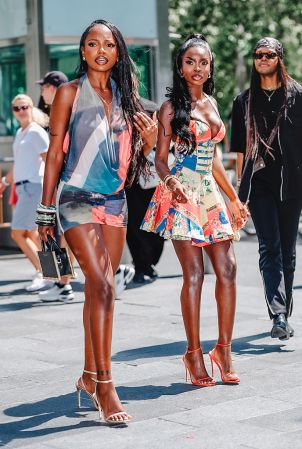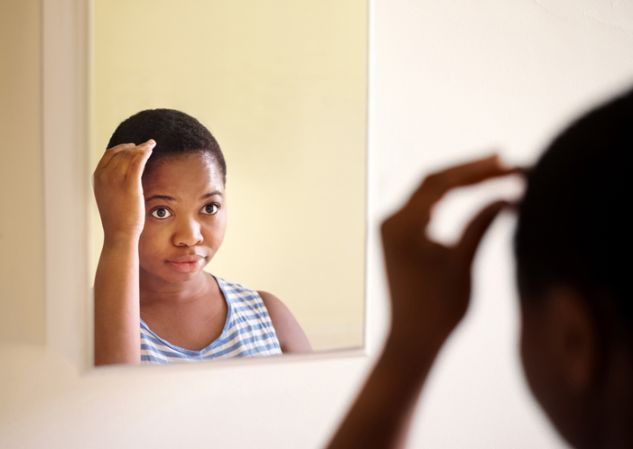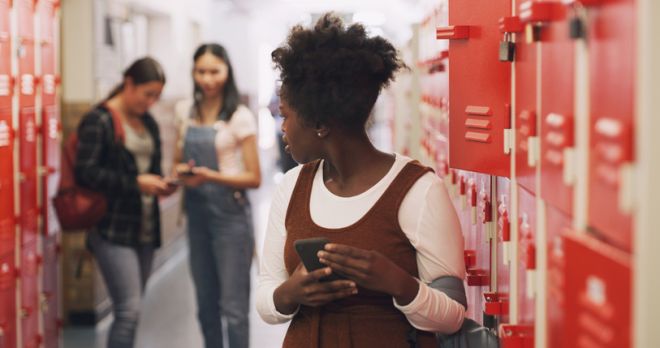'Love Island' Exposes Dating Odds Stacked Against Black Women
Beyond The Villa: How ‘Love Island’ Exposes The Beauty Standards And Dating Odds Stacked Against Black Women [Op-Ed] - Page 3
Share the post
Share this link via
Or copy link

Reality dating shows are marketed as light entertainment—tanned singles in bikinis, messy triangles, and flame-lit kisses. But for Black women, Love Island: USA has never been just a casual search for romance. Every season functions as a social experiment on desirability: who gets picked, who is overlooked, and what beauty choices are deemed acceptable under the ever-present white and male gaze.
Yeah, it’s really like that, as viewers get to watch couples date in real-time. Often, you can watch as some get “pulled for chats” and others may not. Or, as soon as a bombshell enters the villa, an OG might be at risk of getting sent home.
Love MadameNoire? Get more! Join the MadameNoire Newsletter
We care about your data. See our privacy policy.
Of course, that’s the point—to watch these sexy people casually search for their possible significant other, but producers are in charge of casting on compatibility since the Islanders go through a rigorous screening process. So, if you’re rooting for #BlackLove, the dating choices and couples to vote for may look different.
RELATED CONTENT: ‘Love Island’ Breakup Chaos: JaNa Craig And Castmates Drag ‘Racist’ Kenny Rodriguez For Being A ‘Manipulative Liar’
Black women face stacked odds in dating—both in real life and on reality TV. The Pew Research Center states that Black women are 62% more likely to be unpartnered than Black men, and an OkCupid analysis shows they receive the lowest response rates of any demographic on dating apps.
On Love Island, that imbalance plays out visibly: from the U.K. to the U.S. version, Black women are often picked last or eliminated first, a pattern fans and media have called out repeatedly. Speaking of called out, stay tuned for the Love Island USA 2025 Reunion on Monday night. It will surely be a dramatic scene as these conversations continue post-island adventure in the real world. Whew!
According to Teen Vogue, Season 6 winner Serena Page admitted she auditioned with a wig because she feared her braids would keep her from being cast. When she later appeared on set with braids, producers allegedly told her she “looked different,” which left her in tears. That vulnerability shows how, from the start, Black women have to negotiate beauty politics just to secure visibility.
A Scandal Beyond Appearance
The news of one of Love Island‘s beloved couples from season 6 broke the internet. In Decider, the Beyond the Villa spinoff exposed something darker than a simple breakup. Allegations surfaced that Kenny Rodriguez cheated on Jana Craig and made racist remarks about Black women. Jana herself described the truth as “terrible, disgusting, and disappointing.”
Cosmopolitan reports that co-stars quickly rallied around Jana. Serena Page said she had “no respect” left for Kenny, Leah Kateb accused him of being “racist, clout/money hungry and a scammer since Day 1.”
Kaylor Martin declared she would “never speak” to him again, calling him “a poor excuse of a man.”
According to People, screenshots shared online allegedly revealed Kenny saying, “I don’t like Black women,” and admitting to faking the relationship for clout. For many fans, the scandal highlighted how fragile desirability politics become when the illusion of the villa collapses.
This has sparked online conversations around racism and colorism. Having to endure what you thought was a real relationship in front of the world to see is no small feat. How heartbreaking for Black women to go on a show intended for love and find out it was a lie? A lovergirl’s fear!
A Timeline of Hair in the Villa
Justine Ndiba — Braids as Breakthrough
According to Justine Ndiba’s YouTube channel, the season 2 winner detailed the hours-long process of installing and maintaining braids while living in the villa. Fans echoed her honesty on Reddit, praising her for showing the labor behind protective styling and celebrating her authenticity.
Cashay Proudfoot — Bald by Choice
According to Screen Rant, season 3 original Cashay Proudfoot revealed she shaved her head before filming and was told by producers that she was cast because of her natural look. Her baldness became a bold statement of self-definition in a genre long dominated by wigs and weaves.
Trina Njoroge—The Quiet Middle
Trina’s polished leave-outs and sleek styles reflected a safer, “villa-ready” aesthetic. Placed next to Cashay’s bald look, it underscored the choices Black women must navigate between fitting into mainstream desirability and leaning into personal authenticity.
Seasons 5 & 6 — A New Era of Visibility
Season 5 marked an increase in darker-skinned Black women like Destiny Davis, Kay Kay Gray, and Imani Wheeler. By season 6, women like Serena Page, Jana Craig, and Daia McGhee openly spoke about their hair choices.
On Smith Sisters Live, Serena notes the fan appreciation she received when switching between wigs and braids.
Daia discusses presenting natural hair during Casa Amor on the podcast, So Bad It’s Good with Ryan Bailey.
RELATED CONTENT: Soft Girls Don’t Chase—They Choose: Why Black Women Are Curating Ease Over Exhaustion
RELATED CONTENT: To The Black Girl Avoiding The Pool Party: A Love Letter
The Weight of the Gaze

Mind you, if you know how natural hair works, it changes with the elements. Island weather is unpredictable, and cameras are on you at every angle. Black women have these considerations when having to do their own hair on set and in between challenges that can get pretty messy. You’ll also get screenshots and photos circulating online forever, so you have to look on point!
According to a fan post on Reddit’s r/LoveIslandUSA, one viewer summed up the practicality of braids in the villa: “I’m braids gang…you’d never catch me on a TV show being filmed 24/7 in a wig,” underscoring how protective styles function as both cultural expression and a survival tactic under the heat and scrutiny of reality TV.
In a tweet on X, user @fulfiliahair celebrated Serena Page’s hair versatility: “Obsessed with Serena and how she styles her goddess braids different everyday, such great rep #loveislandusa.” That kind of feedback shows how fans link representation directly to self-styling choices—and see them as larger statements about Black beauty on mainstream TV.
According to recent reporting by Teen Vogue, contestants like season 7’s Olandria Carthen and Chelley Bissainthe explained that they maintained their knotless braids themselves and even cared for each other’s hair without professional support on set. Despite this, they faced criticism online for their styles appearing “messy”—a double standard rarely applied to their non-Black castmates.
Together, these reactions highlight the double bind Black women navigate in the villa. Braids are culturally functional yet still coded as “unpolished.” Wigs and weaves often win safer approval because they align with Eurocentric ideals. And natural hair or baldness, like Cashay Proudfoot’s season 3 shaved head, may be praised as radical authenticity but can also leave women vulnerable to fetishization or being overlooked in the coupling process.
Beyond Hair: The Next Frontier of Representation
Producers have started to push casting boundaries. Season 7 introduced islander Huda, a mother, which was a big deal for the show. Previously, season 5 featured an islander named Carsten “Bergie” Bergersen. He was sent home and brought back so that he could find love. It is noted that Bergie was a white male, unconventional contestant who didn’t “fit” the chiseled villa body mold.
These choices suggest some willingness to diversify. But the question remains: when will the same effort be applied to casting curvier women with real bodies or Black women with natural hair?
Why This Matters Off-Screen

For my own family, watching these shifts season to season has become ritual—and a case study. Love Island now offers more post-show support, from endorsement deals to mental health care. That’s progress. But as noted by People, the weight of representation still falls hardest on Black women, who must embody authenticity and resilience while fighting against erasure.
A common (minimizing) take on this is that these moments are not “deep,” but on the contrary. Love Island is a top-rated show with millions of viewers on average. The show features young adults, with faces that have flooded not only our television screens but also our social media—where many young black girls are. So let’s not be pedestrian.
The Jana and Kenny scandal proved that beneath the glossy villa illusion lies something deeper: fractures that reveal how Black women are treated, styled, and dismissed—both on-screen and in the real world.
At the End of the Day: Black Women, Continue to Show Up
Hair in the villa may look like just another beauty choice, but for Black women it carries weight, history, and resilience. Each braid, wig, twist, or bald head reflects a decision to show up authentically in a space that hasn’t always welcomed us fully.
What Love Island has revealed—season after season—is that Black women continue to expand the definition of beauty on mainstream TV. Even under the pressures of desirability politics, they model versatility, creativity and courage. They spark conversations that ripple far beyond the villa and force viewers, producers and entire industries to reimagine what representation looks like.
So while the villa may be framed as a game of who gets chosen, Black women are reminding us that the real victory lies in showing up as yourself. In that sense, they aren’t just playing the game—they’re rewriting it.
With the highly anticipated season 7 reunion airing Monday, August 25, at 6 p.m. PT / 9 p.m. ET on Peacock—hosted by Ariana Madix and Andy Cohen—these conversations about representation, desire, and visibility are set to continue in real time. Check out this tease:
RELATED CONTENT: Hot Girl Takeover: Megan Thee Stallion Shuts Down ‘Love Island’ — Drops Walmart Swimwear & Jaws
Related Tags
Beauty politics Beyond the Villa black love black women Chelley dating dating competition dating shows JaNa Craig Kenny Rodriguez Kordell Williams love love island Love Island Reunion 2025 Love Island USA natural hair Olandria PPG reality tv Serena Page






